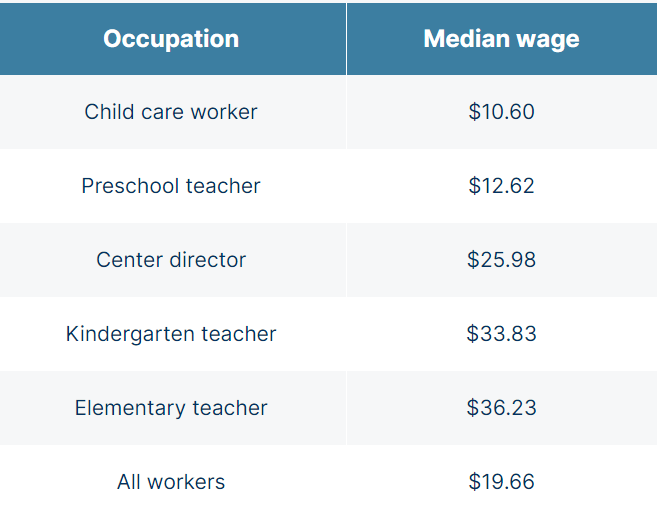In the Midst of a Crisis, Child Care Professionals are Still Underpaid

As we’ve written before, the COVID-19 pandemic has shown just how critical the child care and early learning industry is to a functioning society. Yet the industry remains in crisis. Higher costs associated with pandemic safety protocols, decreased enrollment, and lower revenue forced many child care centers nationwide and in Delaware to close their doors entirely. As of this past August, nationally one in five child care jobs have been lost since the beginning of the pandemic. As of October, the child care industry was 83 percent as large as it was before the pandemic began.
But the harsh reality is: the child care industry was unstable even before the pandemic. At the crux of the problem is a workforce that has been overworked, overlooked, and underpaid for years.
Early learning educators and professionals receive lower pay compared to their K-12 counterparts—about half as much for a job that is full day, full year, and typically without benefits of paid time off. As of 2018, one in 10 child care workers had incomes that fell below the federal poverty line, twice the rate of the poverty rate for all workers.
Disparities in pay exist within the early learning workforce as well. Educators and child care professionals who work with infants and toddlers also earn less when compared to pre-K professionals. The early learning workforce in the U.S. is largely made up of women, 40 percent of whom are women of color. Disparities in pay in the early learning sector also extend to race and ethnicity with African American early learning educators earning less than their peers across racial groups.
Poor compensation also negatively impacts quality of early learning. Research shows that the first five years of a child’s life are critical to their learning and development. We also know that talented, well-compensated early learning professionals are central to high-quality early learning and care. Strong relationships with caregivers are essential to early brain development and can have positive effects on a child’s life long health and success. Poor compensation however undermines quality of care and is shown to lead to economic instability, stress, and high rates of turnover among early learning professionals.
In order to support the early learning workforce, there must be an increased investment in compensation so we can pay early learning professionals a living, family-sustaining wage with benefits and retain more early childhood educators to deliver high-quality learning and care.
Delaware Context
Early childhood educators and professionals pay is significantly lower than their K-12 counterparts. As of 2019, the average annual salary in Delaware for a pre-K teacher is $27,820. A kindergarten teacher and an elementary school teacher each make more than double that amount earning an average annual salary of $61,040 and $63,970, respectively.
Early childhood care and education professionals receive poor compensation and lack benefits. As of 2020, the hourly average wage in Delaware for a pre-K teacher is $12.62. For a child care worker in Delaware, the average hourly wage is $10.60. A 2016 report showed that 75 percent of early childhood professionals receive an hourly wage for their work rather than a salary with benefits. Legislatively, Delaware has introduced a minimum wage bill that could have implications for the early learning workforce. If the bill passes and the minimum wage goes up, contracts from the state to the child care industry will have to increase to cover that difference.

Source: Center for the Study of Child Care Employment. (2020). Early learning workforce index 2020: Delaware
Many child care professionals do not receive benefits and have to work a second job. Only 40 percent of early learning professionals in Delaware have healthcare benefits. Many miss out on other benefits, such as planning time and paid time off, unlike their K-12 counterparts. Without a livable wage and benefits, many child care workers have to maintain a second job to supplement their income, which includes about 13 percent of child care workers in Delaware.
There is no wage scale for early childhood educators and early learning professionals. In addition to the glaring differences in pay, salaries for K-12 public school teachers are rooted in a wage scale, or pay schedule, that sets a base salary for all educators and serves as an incentive for educators to increase their level of educational attainment as they increase their years of experience. No such scale or incentive exists for pre-K or early learning educators and workers in Delaware. Therefore, there is no base, or starting salary for early learning professionals and no career pathway with financial incentives to increase their level of education along stackable credits, credentials, and experience—which several other states have created.
Programs and initiatives have helped to financially support the early learning workforce, but none address the underlying system that allows the workforce to go underpaid. Over the years, organizations like the Delaware Association for the Education of Young Children (DEAEYC) and $tand by Me have worked to create and implement programs that help to financially support early childhood professionals. Programs and initiatives include:
- $tand by Me financial coaching provided to early childhood workforce and families
- Child Care WAGE$ Program salary supplement to increase support retention
- T.E.A.C.H. Early Childhood Delaware scholarship to serve CDA, AA, and BA candidates
Delaware’s continued investment and expansion of these programs are critical to support the early learning workforce, but it is also crucial that policy action on structural change to compensation exists.
What Are Other States Doing?
Many states implement similar initiatives like scholarships or wage supplement programs to support early learning compensation and do not include large-scale changes necessary to increase compensation. Some states, however, have taken steps to initiate and enact structural changes to early learning workforce compensation, including pay parity and establishing a target wage scale for the early learning workforce.
At least 18 states have established a form of pay parity, or the alignment of pay for pre-K teachers (those who teach three– and four-year–olds in state–funded settings) and K-12 teachers, according to NCSL. Two examples include Georgia and Alabama, states that used an incremental approach to ensure pre-K teachers across all settings (public and private) receive the same minimum or starting salary. However, no states have extended pay parity to other child care workers.
States have also proposed and/or developed a wage scale for the early learning workforce.
- In 2019, Connecticut passed a wage scale bill that requires the Office of Early Childhood to develop a proposed wage scale for state funded pre-K and child care centers.
- Also in 2019, North Carolina’s legislature introduced (but did not pass) a bill that would have established a salary scale and created an incentive fund for programs that opted to adopt the scale. This bill would have also required a feasibility and cost study on payment, training, recruitment, and attainment of higher education for early childhood educators.
- Rhode Island recently reintroduced the Rhode Island Early Educator Investment Act, which would include strategies to improve compensation for early educators. If passed, it would (among other things) create a non-mandatory target wage scale linked to education levels and demonstrated competence working with children.
Where Do We Go From Here?
There are initial steps Delaware can take to enact structural change and improve compensation for the early learning workforce. Some recommendations include:
- Adopt a professional pathway like the National Association for the Education of Young Children’s Power to the Profession (NAEYC).
- Adopt an associated target wage scale for early childhood educators that will improve compensation and set a base salary for all workers.
- Use the wage scale to inform the cost of care estimator, an alternative method to the market rate study to estimate the cost of providing child care in Delaware.
- Build in requirements and incentives for workforce support and qualifications into the new Quality Rating and Improvement System, the method Delaware uses to rate, improve, and communicate quality of early care.
- Leverage new stimulus dollars from the American Rescue Plan to support the workforce through scholarships, compensation initiatives, and redesigning higher education to support the current workforce.
Related Topics: covid-19, delaware early learning, Delaware education, early child care funding, early learning workforce